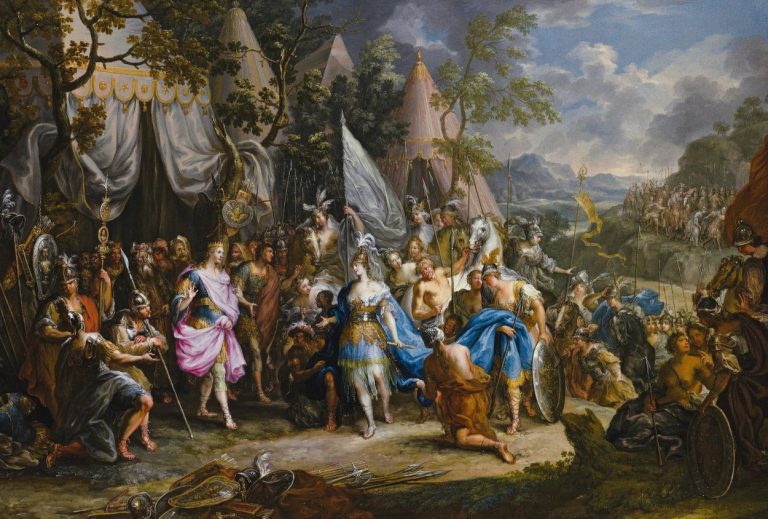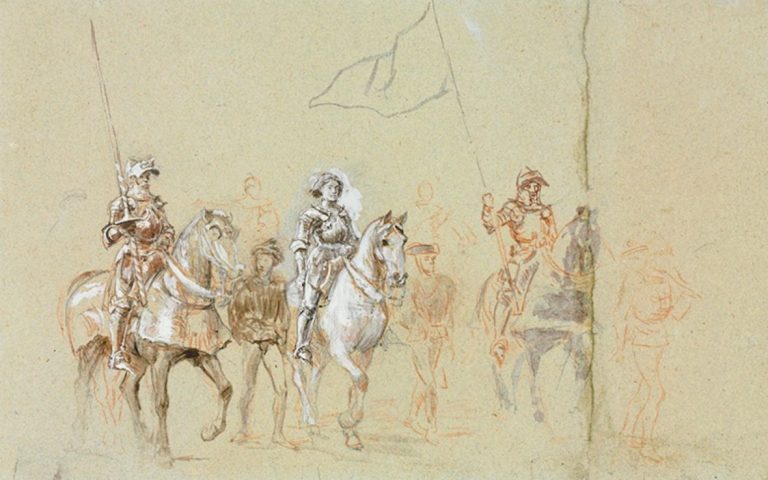
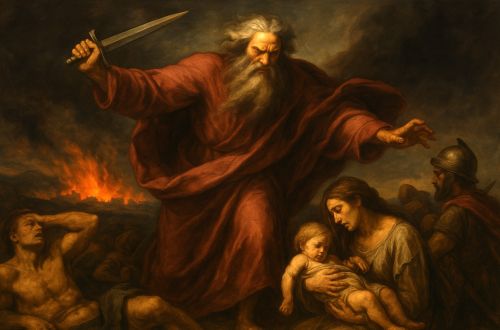
To worship the biblical God as “author of life” is to venerate a being who repeatedly chose death as the means of order. If this is the author of life, it is life defined by ownership, not reverence, by dominion, not mercy.

By Matthew A. McIntosh
Public Historian
Brewminate
Introduction: The Problem of Divine Life and Death
The water rises slowly at first, lapping against doorposts and the edges of a field where a child’s toy floats away. Within hours, the valley has become a sea. Voices call from rooftops and then disappear beneath the sound of rain and breaking wood. By nightfall, there is no one left to cry. The storm has done what it was commanded to do. In the silence that follows, a small ark drifts above the graves of a world, and the text says that God looked upon the smoke of sacrifice and was pleased.1
This is the first moral paradox of the Abrahamic scriptures: a deity who laments human corruption and then answers it with extermination. The pattern begins with water but does not end there. The same God who claims to have formed life in the womb drowns that life without hesitation, orders the slaughter of infants in Egypt and Canaan, and treats the unborn as property rather than person. The Hebrew bible presents a god of birth and burial in one breath, a being whose justice expresses itself through annihilation.
The following analysis confines itself to the texts as written, not to later theology, allegory, or apology. Its aim is not to interpret divine intent but to examine divine action, and to confront the ethical structure of those actions as they appear in law, narrative, and prophecy. Within those pages, the supposed “sanctity of life” dissolves under the weight of sanctioned violence. The God who creates is also the God who kills, and the moral center of scripture turns not on the preservation of life, but on the obedience demanded before death.
The Flood and the Logic of Total Annihilation
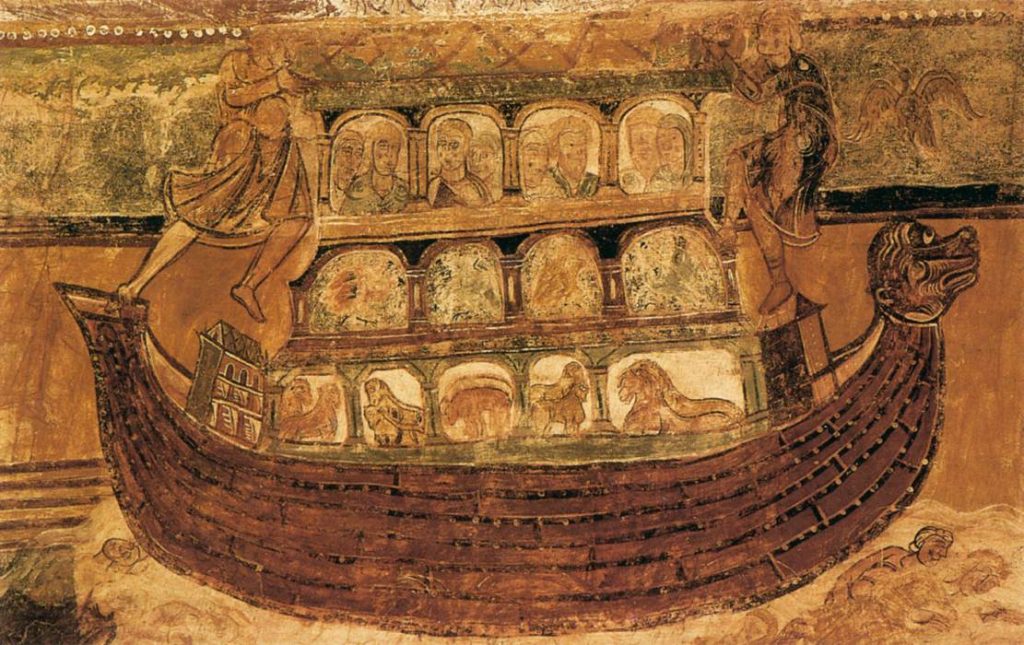
The flood narrative opens with divine regret. “The Lord saw that the wickedness of man was great in the earth… and the Lord was sorry that he had made man on the earth, and it grieved him to his heart.”2 The text is anthropomorphic (grief, sorrow, change of mind) but the emotion resolves not in compassion or correction, but in extermination. God’s repentance births the largest act of violence in the biblical canon. The world itself becomes the weapon.
The destruction is deliberate and absolute. Every living creature perishes “of all that was on the dry land, in whose nostrils was the breath of life.”3 There is no distinction of guilt or innocence, no individual judgment. Pregnant women drown beside their infants. The moral calculus is collective: humanity has failed, and so life itself must end. The narrative pauses only to ensure that the command has been fulfilled: “Only Noah was left, and those that were with him in the ark.”4 What remains of creation is a remnant sealed in wood.
When the waters recede, the story turns to ritual. Noah builds an altar, slaughters animals, and burns them as a sacrifice. The text records, with striking intimacy, that “the Lord smelled the pleasing odor.”5 It is this scent, not the survival of humanity, that moves God to promise restraint: “I will never again curse the ground because of man.” Divine satisfaction comes not from sparing life but from the aroma of its destruction. The offering is an echo of the dead world beneath the ark, a miniature repetition of what has just been done on cosmic scale.
The logic of the flood reveals a theology of purification through death. The world’s renewal requires that the world first be drowned. The same pattern will govern later wars and judgments: corruption is met not with healing but with obliteration. God’s grief leads not to reform, but to a reset purchased in blood and water. If omnipotence implies choice, then the moral riddle is not that God could destroy, but that he preferred to.
Infanticide and Divine Spectacle: From Egypt to Canaan

The flood leaves the earth cleansed by death, but the divine appetite for destruction continues. When the narrative turns from water to empire, the killing becomes selective, no longer universal, but exemplary. Egypt and Canaan serve as stages upon which God’s sovereignty is proven through the deaths of the young.
In Exodus, God announces that Pharaoh’s refusal to free the Israelites will end not in negotiation but in bereavement. “Every firstborn in the land of Egypt shall die, from the firstborn of Pharaoh who sits on his throne to the firstborn of the slave girl who is at her mill.”6 The violence is direct, divine, and total. The text insists that God “hardened Pharaoh’s heart” so that the plagues might multiply, a theological circle in which resistance is created in order to justify punishment.7 At midnight, the angel of death passes through Egypt, and “there was not a house where someone was not dead.”8 The deaths of children, human and animal alike, become the proof of divine distinction: Israel’s blood-marked doors testify to election; Egyptian infants testify to rejection.
This same logic of selection drives the conquest narratives. In Deuteronomy, the Israelites are told to show the Canaanites “no mercy” and to “utterly destroy them.”9 Joshua’s campaigns carry out the command with ritual precision: “They devoted to destruction all in the city, both men and women, young and old, oxen, sheep, and donkeys.”10 The Hebrew term ḥerem, “devoted to destruction,” is cultic. It denotes not merely killing, but consecration through extermination. The slaughter is holy, and the totality of it is what makes it righteous.
The command reaches its most explicit form in the war against Amalek. The prophet Samuel delivers God’s order to King Saul: “Now go and smite Amalek, and utterly destroy all that they have; do not spare them, but kill both man and woman, infant and suckling, ox and sheep, camel and ass.”11 Saul’s partial disobedience, his decision to spare the king and a few animals, results in divine rejection. The moral of the story is not that killing is wrong, but that mercy is rebellion.
In Numbers, the war against Midian turns the pattern into administration. After battle, Moses condemns his soldiers for sparing women and children. “Now therefore kill every male among the little ones, and kill every woman who has known a man by lying with him.”12 Only virgin girls are to be kept alive, their fates tallied alongside cattle and gold. The numbers are recorded carefully, as though genocide were an act of accounting.
Across these texts, divine violence becomes spectacle, a theater of obedience. Innocence carries no protection; disobedience to divine wrath carries death. The slaughter of children is not an accident of war but its fulfillment, proof that human life itself is expendable in the service of divine will. Within these stories, holiness is measured not by compassion, but by the completeness of annihilation.
The Unborn: Scriptural Devaluation of Fetal Life
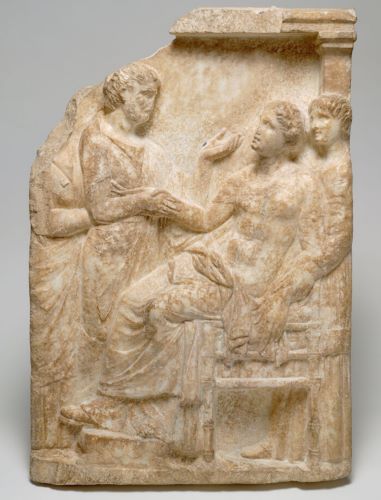
The biblical text never elevates the fetus to the status of a living person. In every case where unborn life appears, it exists as property, potential, or collateral, not as an individual bearing divine image or moral worth.
The law in Exodus 21:22–25 is the clearest articulation of this hierarchy. If people fighting injure a pregnant woman so that she miscarries, the offender pays a fine. Only if the woman herself dies is the penalty “life for life.”13 The fetus carries no independent value; its loss is a civil infraction, not a capital crime. The Hebrew wording, yatsa yeledêha, “her offspring come out,” describes miscarriage, not premature birth. The distinction is reinforced by the clause “if there is no further harm,” referring to the mother’s survival. This legal formulation establishes a scale of worth: fetus below woman, and in a patriarchal society, woman below man.
The creation account in Genesis 2:7 supports this hierarchy. Adam becomes a “living being” only when God breathes into him “the breath of life.”14 The defining act of animation is respiration, not conception. In the Hebrew mind, life begins at first breath, and death is marked by its loss. Nowhere in the Hebrew scriptures does the text equate conception with personhood. The living are those who breathe; the unborn are the not-yet.
Elsewhere, the unborn appear only as extensions of divine punishment. In Hosea 13:16, God declares, “Their infants shall be dashed in pieces, and their pregnant women ripped open.”15 In Amos 1:13, the same image appears: “They ripped open pregnant women in Gilead.” The text presents these acts not as human atrocities but as instruments of divine justice. The womb itself becomes a battlefield, the fetus a symbol of collective guilt.
Even within the covenant community, the unborn are expendable when divine anger flares. The flood destroys them without mention; the plagues strike them alongside the living; the wars of conquest erase them with the rest. The Hebrew bible does not depict a God who cherishes fetal life, but one who ends it without hesitation when wrath demands.
In the moral economy of scripture, birth, not conception, marks the threshold of life, and even birth offers no guarantee of protection. The unborn, like the born, survive only at the pleasure of a God whose justice sanctifies their destruction.
The Living Child as Target

If the unborn are expendable, the living child fares little better. The biblical record repeatedly presents the death of children not as tragedy but as proof of divine authority. From private households to besieged cities, the young are consumed as instruments of justice, warning, or spectacle.
The story of David’s infant son in 2 Samuel 12 reveals how innocence itself becomes a medium of punishment. After David’s adultery with Bathsheba and his orchestration of Uriah’s death, the prophet Nathan declares that “the child that is born unto you shall surely die.”16 The infant falls ill for seven days while David fasts and prays for reprieve. When the child dies, the king rises, bathes, and worships. The text offers no divine regret, only a lesson in submission. The moral is obedience, not mercy; the death of the child reaffirms divine justice, not its absence.
In Lamentations, child death expands from the domestic to the national. During Jerusalem’s siege, famine drives mothers to cannibalism: “The hands of compassionate women have boiled their own children; they became their food.”17 The author attributes the horror directly to Yahweh: “The Lord has fulfilled his wrath; he has poured out his fierce anger.”18 The suffering of children is the narrative’s emotional climax, an image of total divine abandonment. The point is not moral outrage but completeness of punishment.
Even more grotesque in its simplicity is the story of Elisha and the bears in 2 Kings 2:23–24. As the prophet walks toward Bethel, a group of boys mocks him, crying, “Go up, you baldhead!” Elisha curses them in the name of Yahweh, and “two she-bears came out of the woods and mauled forty-two of the boys.”19 The text records no shock or reprimand, only Elisha’s continuation on his journey. The divine sanction is implicit in the prophet’s success. The offense is ridicule; the consequence is death. Authority is affirmed through fear.
Together, these accounts illustrate a theology in which the child’s life is conditional and contingent. Innocence offers no immunity; vulnerability becomes the occasion for power to display itself. The God of these narratives measures faith not by compassion for the weak but by acceptance of their loss. The living child, like the unborn, serves as a canvas for divine anger, a means by which power justifies itself.
The Pattern of Sanctified Violence

Across the narratives of flood, conquest, and plague, the pattern of divine violence becomes unmistakable. Each episode varies in scale and setting, yet all express the same moral architecture: death is holy when commanded by God, and destruction is the measure of faith.
The first element of the pattern is totality. Whether the target is humanity as a whole or a single tribe, divine wrath never stops short of extermination. When the Israelites march through Canaan, their victory songs praise not survival but annihilation. “They left nothing that breathed,” the Book of Joshua repeats, transforming massacre into liturgy.20 Partial mercy, as in Saul’s sparing of Amalek’s king, is treated as rebellion. The narrative rewards only those who carry destruction to completion.
Second is the sacralization of death. The Hebrew term ḥerem, “devoted to destruction,” links warfare to ritual.21 To kill under divine order is to consecrate; to spare is to profane. The battlefield becomes an altar where obedience is proven through blood. Even acts of private punishment, like the killing of David’s child or the bears’ mauling of boys, share the same structure: moral offense purified through violence, sanctity restored through fear.
A third element is the absence of divine remorse. In every case, once judgment is executed, the text moves on without reflection. After the flood, God promises restraint but never expresses sorrow for the dead. After the plagues, Egypt’s mourning fades beneath Israel’s songs of deliverance. The silence is theological: divine will, by definition, cannot err. What would be cruelty in a human becomes holiness in God.
The cumulative effect is a portrait of sovereignty unbound by ethics. The deity who claims creation’s authorship also claims its right to erase.22 The result is a god of absolute dominion, one whose justice is not tempered by compassion but defined by command. Within this scriptural framework, morality flows downward from power: what God does is good simply because God does it. What God says is good simply because God says it.
This is the root contradiction of later religious moralism. The same tradition that elevates “life” as sacred begins with a deity who perfects holiness through slaughter. The sacred text sanctifies obedience, not empathy, and in doing so transforms violence into virtue.
From Breath to Conception: The Post-Biblical Invention of “Life”
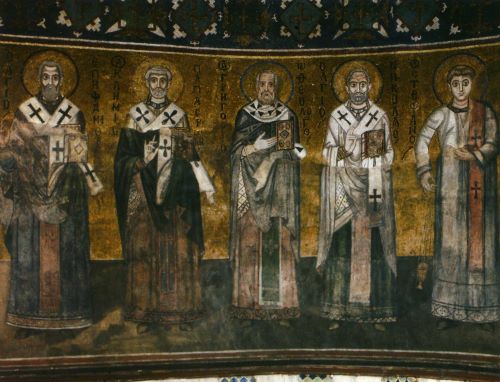
The moral vocabulary of “life” as sacred begins not in scripture but in philosophy. The Hebrew bible grounds existence in breath, not conception; the fetus is potential, not person. It was only centuries later, under the influence of Hellenistic and scholastic thought, that the concept of life at conception emerged. The transformation from breath to embryo marks one of the most profound theological reversals in Western history.
Early Christianity inherited the Hebrew canon without revising its valuation of the unborn. The New Testament offers no doctrine of fetal personhood and never equates abortion with murder.23 The first Christians, living under Roman law, absorbed Greco-Roman categories of ensoulment rather than biblical ones. Aristotle had argued that the soul entered the body only after formation, forty days for males, ninety for females.24 This view of delayed ensoulment shaped Jewish thought in the Hellenistic period and passed directly into early Christian teaching.
Augustine of Hippo adopted this model in the fourth century. For him, abortion before ensoulment was a sin of lust or disobedience, not homicide.25 His concern was moral discipline, not the fetus itself. The issue of “life” remained undefined, because the biblical text offered no foundation for its sanctity. The question was metaphysical, not ethical: when does a body become a soul?
Thomas Aquinas, writing eight centuries later, systematized Augustine’s inheritance. Drawing again on Aristotle, he affirmed that the rational soul entered the body only when the embryo was sufficiently formed to receive it.26 Before that moment, the embryo possessed only a vegetative or animal soul. Aquinas condemned abortion as contrary to nature but not as murder, a position consistent with both reason and scripture. There was still no theological claim that God infused life at conception.
The modern “pro-life” doctrine arose far later, in the wake of Enlightenment natural law and nineteenth-century Catholic reform. As embryology advanced and secular philosophy displaced Aristotelian biology, theologians sought new grounds for moral authority. They moved conception to the center of the moral stage, redefining life as a fixed divine essence rather than a process.27 This was not a recovery of biblical teaching but an invention meant to defend religious relevance in an age of science and liberalism.
By the twentieth century, the shift was complete. Political movements, first in Catholic Europe, then in the American evangelical right, merged theology with ideology. “Life” became a slogan, detached from its scriptural roots and refashioned into moral weaponry. The ancient deity who commanded slaughter was reborn as a patron of the unborn. The contradiction is stark: a faith that canonized divine genocide now preaches absolute sanctity of life. The “pro-life God” is not a revelation of scripture but a creation of history.
Conclusion: The God Who Chose Death
From the flood to the plagues, from the slaughter of Canaan to the death of David’s child, the biblical God reveals a consistent moral logic: life is sacred only when it serves divine will. The text never celebrates preservation for its own sake. It sanctifies destruction when commanded, and it blesses survival only as proof of obedience. Holiness, in this vision, does not protect the living; it defines who may be killed and why.28
The moral center of the Hebrew bible rests not on compassion but on hierarchy. God creates and therefore claims the right to uncreate. The command to destroy becomes a test of loyalty, and the worshiper’s virtue lies in submission to that order. The modern reader confronts not a deity of life, but a sovereign who rules through death, a being whose justice is indistinguishable from annihilation.29
Later theology would soften these images, turning blood into metaphor and violence into allegory. Yet the textual record endures, unedited and unrepentant. The same God who delights in the scent of burnt offerings, who drowns the innocent and kills the firstborn, stands at the foundation of traditions that now proclaim the sanctity of life. The contradiction is not peripheral; it is structural. The scriptures that define divine morality also expose its moral collapse.30
The pro-life ethic of modern Christianity depends upon forgetting this foundation. It requires the faithful to extract compassion from stories of slaughter and to imagine a moral continuity that the text itself denies. To worship the biblical God as “author of life” is to venerate a being who repeatedly chose death as the means of order.
If this is the author of life, it is life defined by ownership, not reverence, by dominion, not mercy. The God who formed humanity from dust has, throughout his own story, preferred to stomp on the dust at the slightest provocation. From dust to dust, indeed.
Appendix
Footnotes
- Genesis 8:20–21 (New Revised Standard Version).
- Genesis 6:5–6 (New Revised Standard Version).
- Genesis 7:22.
- Genesis 7:23.
- Genesis 8:21.
- Exodus 11:5 (New Revised Standard Version).
- Exodus 9:12.
- Exodus 12:30.
- Deuteronomy 7:2.
- Joshua 6:21.
- 1 Samuel 15:3.
- Numbers 31:17.
- Exodus 21:22–25 (New Revised Standard Version).
- Genesis 2:7.
- Hosea 13:16; see also Amos 1:13.
- 2 Samuel 12:14–20 (New Revised Standard Version).
- Lamentations 4:10.
- Lamentations 4:11.
- 2 Kings 2:23–24.
- Joshua 10:40 (New Revised Standard Version).
- Deuteronomy 7:2; Numbers 31:17.
- Genesis 6:7; Exodus 12:29–30.
- See Luke 1:41–44; Romans 9:11; none define personhood before birth.
- Aristotle, Generation of Animals, II.3 (736b–737a).
- Augustine, On Exodus Questions, II.80; City of God, I.20.
- Thomas Aquinas, Summa Theologica, I, q. 118, a. 2; II-II, q. 64, a. 8.
- John T. Noonan Jr., An Almost Absolute Value in History (Cambridge, MA: Harvard University Press, 1970), 3–19.
- Genesis 6–9; Exodus 12:29–30; Joshua 6:21; 2 Samuel 12:14–20; Genesis 8:20–21.
- Phyllis Trible, Texts of Terror: Literary-Feminist Readings of Biblical Narratives (Philadelphia: Fortress Press, 1984), 1–5.
- Eric A. Seibert, Disturbing Divine Behavior: Troubling Old Testament Images of God (Minneapolis: Fortress Press, 2009), 42–58.
Bibliography
- Aquinas, Thomas. Summa Theologica. Translated by the Fathers of the English Dominican Province. New York: Benziger Bros., 1947.
- Aristotle. Generation of Animals. Translated by A. L. Peck. Cambridge, MA: Harvard University Press, 1942.
- Augustine. City of God. Translated by Henry Bettenson. London: Penguin Books, 2003.
- ———. On Exodus Questions. In Answer to the Questions on Exodus, translated by Edmund Hill. Hyde Park, NY: New City Press, 2002.
- Holy Bible. New Revised Standard Version. Nashville: Thomas Nelson, 1989.
- Noonan, John T. Jr. An Almost Absolute Value in History. Cambridge, MA: Harvard University Press, 1970.
- Seibert, Eric A. Disturbing Divine Behavior: Troubling Old Testament Images of God. Minneapolis: Fortress Press, 2009.
- Trible, Phyllis. Texts of Terror: Literary-Feminist Readings of Biblical Narratives. Philadelphia: Fortress Press, 1984.
Originally published by Brewminate, 10.19.2025, under the terms of a Creative Commons Attribution-NonCommercial-NoDerivatives 4.0 International license.

